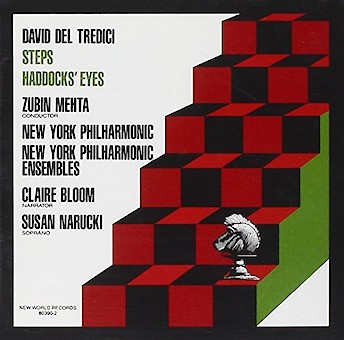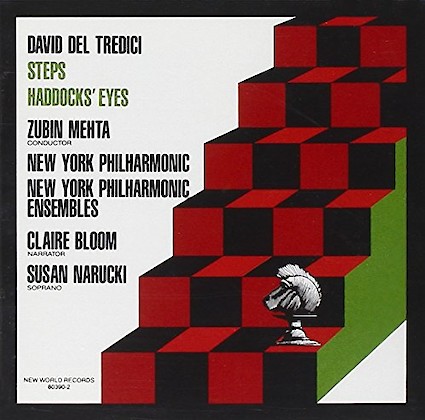Is the White Knight, who sings Alice his famous nonsense song in Through the Looking-Glass, really a caricature of Lewis Carroll himself? Martin Gardner, in The Annotated Alice, thinks so.
Like the knight, Carroll had shaggy hair, mild blue eyes, a kind and gentle face. Like the knight, his mind seemed to function best when it saw things in topsy-turvy fashion. . . Of all the characters Alice meets on her two dream adventures, only the White Knight seems to be genuinely fond of her and to offer her special assistance... His melancholy farewell may be Carroll's farewell to Alice when she grew up (became a queen) and abandoned him. At any rate, we hear loudest in this episode that "shadow of a sigh" that Carroll tells us in his prefatory poem will "tremble through the story."
This interpretation of the eccentric Knight won me over the moment I read it. Music, I realized, could not only serve his madcap verse but could, as well, bring to life a touchingly personal dimension.
I learned further from Mr. Gardner that when Alice says, "But the tune isn't his own invention, it's 'I give thee all I can no more,'" she is actually quoting the opening line of a Thomas Moore poem, My Heart and Lute. Reading Moore's complete text reveals a lyric full of yearning and unrequited love. Is Carroll hinting here at the true depth of his infatuation for the real life Alice? The thought quickened my musical pulse—unrequited love, after all, has enjoyed a long and singularly requited association with music.
Finally, Gardner declares, "It is quite possible that Carroll regarded Moore's love lyric as the song that he, the White Knight, would have liked to sing to Alice but dared not." Well, I thought, if he dares not sing his song than I will! The desire to set these diverse yet provocatively conjoined texts became irresistible, so much so, in fact, that one night I dreamed the first two measures of the WHITE KNIGHT'S SONG. That led to the hard part—believing in, accepting such a mysterious serendipity. However, once those "dream" notes were written down the whole piece seemed quite suddenly to just be. Each day, while I sat at the piano, the music would come unbidden, unexpected, and unpremeditated, leaving me in a state of exhaustion and excitement. Twenty such days provided the twenty minutes of Haddocks' Eyes.
At the center of the piece I have placed Moore's "forbidden" love lyric. This ARIA is preceded by a CADENZA and followed by an INTERLUDE. Moving further from the center, dual settings of the WHITE KNIGHT'S SONG form the next "surround." Completing the symmetrical frame, standing as the outermost parentheses, as it were, are an INTRODUCTION and a FAREWELL.
In the spoken INTRODUCTION, Gardner suggests, "Carroll is distinguishing among things, the name of things, and the name of the name of things. To a student of logic and semantics all this is perfectly sensible." The WHITE KNIGHT'S SONG (I) is a "patter" song, the words spilling out with increasing frenzy as the blissfully confused Knight careens from one hilariously cracked image o another. The musical setting is meant to be at once funny, brusque and breathless—a kind of infernal perpetuel mobile machine ever in danger of flying apart. Only at the penultimate line, "That summer evening long ago," Joes the music mellow. Indeed, as the piece progresses this line becomes a crucial motif, bearing the listener again and again to the rapturous, bittersweet depths of Carrollian sentiment for child friends now grown, gone.
A CADENZA of glittering piano virtuosity leads to the central ARIA: My Heart and Lute.
In stark contrast to knightly nonsense this revelatory poem is set as a love song of unabashed romantic expression. Beginning tenderly, horn trailing canonically behind the voice, the music rises two times to climactic outpourings with the words "I give thee all, I can no more." A final repetition of "no more!" has its inevitable effect: the amorous mood is shattered and the music abruptly breaks off. An agitated, churning INTERLUDE follows.
The WHITE KNIGHT'S SONG (II) recapitulates the opening music in a new. gracefully capricious guise. Knightly madness, however, reappears, whipping the music to a manic froth. A triumphant affirmation of "That summer evening long ago" caps the section.
FAREWELL (QUODLIBET): The White Knight's tune is now combined with the melody of the ARIA. Against a shimmering background the soprano recites a quintessentially Carrollian text of fond farewell and nostalgic regret. The piece concludes, however, with a bit of knightly confusion:
"That summer evening long ago,
A-sitting on a gate."
Which line should end the poem? The knight tries one, then the other. He combines bits of each. Finally, as the music vanishes, nonsense reigns.
"long ago, on a gate
long ago, a gate
ago, a gate
a"
Haddocks' Eyes was commissioned by the Chamber Music Society of Lincoln Center and is dedicated to Sylvie Keiser. The piece was written during a residence at The Virginia Center for the Creative Arts.
Del Tredici's devotion to Alice's adventures have already been expressed in his well-received concert works. This one-hour mini-musical is a tidy and tart taste of Carroll's letters and diaries as enacted with meticulously self- amused affection by Tom Hulce as Carroll.
Far from the whimpering, simpering aura of Mozart (whom he portrayed In the film "Amadeus"), fluke proves a tutor of irresistibly wry charm. As a 10-piece orchestra deliciously underscores each of Carroll's fanciful musings on the child Alice, soprano Noemi Nadelmann (as Alice) emerges to sing exquisitely, and Jamie Mills (as young Alice) simply suggests a purely aesthetic vision of a Victorian child.
The most rarefied of these productions is also the most beautiful—and, dammit, the first to disappear. The story of Charles Lutwidge Dodgson's sublimated love for the preadolescent Alice Liddell wouldn't be Christmas entertainment for anyone but a convention of psychoanalysts, except that he paid tribute to her by writing, under the pen name Lewis Carroll, the two most wonderful works of nonsense in the English language. Dodgson was also an important pioneer photographer, and Alice was one of his favorite subjects—until the day her mother drove him from the house, for reasons we will never know. (Some scholars think he asked for the child's hand in marriage.)
Out of this disturbing story, David Warren has built Haddock's Eyes, a one- hour theater piece. Tom Hulce, as Carroll, reads diary and letter excerpts that trace the growth of both his affection for Alice and his scramble to replace his obsession with "inventions" and mathematical games—paralleled in composer David del Tredici's score when a wacky, top- speed setting of the White Knight's Song from Through the Looking-Glass rises up out of the plangent themes that underscore Carroll. - The trajectory of this doomed affair is beautifully shaped in both staging and score: Pedophilia has never seemed so transcendently erotic. The saddest part of all is that, like the White Queen's tomorrow, Haddock's Eyes may vanish before you can catch up with it; the last performances are December 26th Please, Music-Theatre Group, start planning now to bring it back— before next Christmas!
DAVID DEL TREDICI is apparently making a rewarding life's work out of his musical interpretations of Lewis Carroll. Lately he has been sidestepping into related performance areas — into dance with a Glen Tetley ballet, and into theater with 'Haddocks' Eyes." For the Pulitzer Prize-winning composer, the theatrical move seems effortless.
As presented at St. Clement's Episcopal Church by Lyn Austin's Music- Theater Group, "Haddocks'Eyes" is a wry and fanciful excursion into Carroll country. This is no whimsical fairy tale but a chamber musical that distills the intricate Victorian world of the author, as a musical for the stage, the show has an appropriately hard edge of irony as well as a sense of incipient melancholy.
Moving on from Mozart, whom he portrayed in the film "Amadeus," Tom Hulce (in the role of Lewis Carroll) conveys the author's strict sense of propriety along with his odd, obsessive behavior. Re is compulsive about such matters as words, mathematics and little girls — in particular, his dreamchild, Alice Liddell.
The heart of this brief chamber musical is Mr. Hulce quoting from Carroll's diaries and letters, which he does with precise diction and understanding. Underscoring the words is Mr. Del Tredici's richly filigreed score, as played by a 10-piece orchestra that includes the composer on the piano. In keeping with the spoken words (adapted by David Warren), the music is ornate as well as emotionally resonant.
At moments, Noemi Nadelmann sings, her soprano voice merging with the music and completely obscuring the lyrics. Singing or speaking, however, the musical is never patronizing to the author — as he hunts for haddocks' eyes "among the heather bright." The show, directed by Mr. Warren, is an hour of unadulterated Lewis Carroll.
Mr. Hulce describes the first auspicious meeting with Alice (played by Jamie Mills) and her sisters. We hear about their idyllic time together, rowing and listening to Carroll's stories, days the author periodically marks "with a white stone," as a sign of his good fortune.
In addition to Mr. Del Tredici's score and Mr. Hulce's performance, the musical's assets include the set design by John Arnone. In common with his collaborators, Mr. Arnone is highly selective. He makes imaginative use of photographs and labyrinthine patterns, which are reflected on the performers as well as on the walls. The design is one of several aspects of "Haddocks' Eyes" that deserve to be marked with a white stone of good fortune.
Composer David Del Tredici—he of the "Alice in Wonderland" fetish—has often stated he's not interested in writing operas or any other stage works. However, recent events probably have changed his mind. Last year, the National Ballet of Canada turned "In Memory of a Summer Day" into a dance work, and this month, another Alice composition, "Haddocks' Eyes," was transformed into a music-theater piece by the Music-Theatre Group at St. Clement's Church.
"Haddocks' Eyes" was originally a 20-minute work for soprano and chamber orchestra set to the White Knight's Song from "Through the Looking Glass." At the suggestion of director David Warren (who devised a text for three characters taken from Lewis Carroll's diaries), Del Tredici expanded this work to an hour, composing many pages of new music—including a setting of Thomas Moore's "My Heart and Lute"—as well as several purely instrumental passages recalling the composer's other Alice scores.
Warren's scenario for the first time brings Lewis Carroll himself into Del Tredici's music. He is shown to be what he really was—a sensitive, troubled gentleman who had guilt feelings about his obsession with little girls, whom he lived to photograph — preferably in the nude.
"Amadeus" star Tom Hulce was an amazingly believable Carroll, Noemi Madelmann and Jamie Mills were wonderful as both the grown-up and child Alice, and the crack chamber ensemble was flawlessly conducted by Steven Mercurio.
It is a fastidiously made and colorful celebration, one that addresses the whimsical surfaces of Alice's adventures by giving them a dessertlike flavor — sweet, unambivalent, almost Disney-like in its allusions to the English music hall and the Broadway stage.
Audio (1)
Recordings (1)


Haddocks' Eyes, Steps
1992, New World Records (80390-2)Works
Performers
- Zubin Mehta, Conductor
- New York Philharmonic
- Susan Narucki, Soprano
- Claire Bloom, Narrator